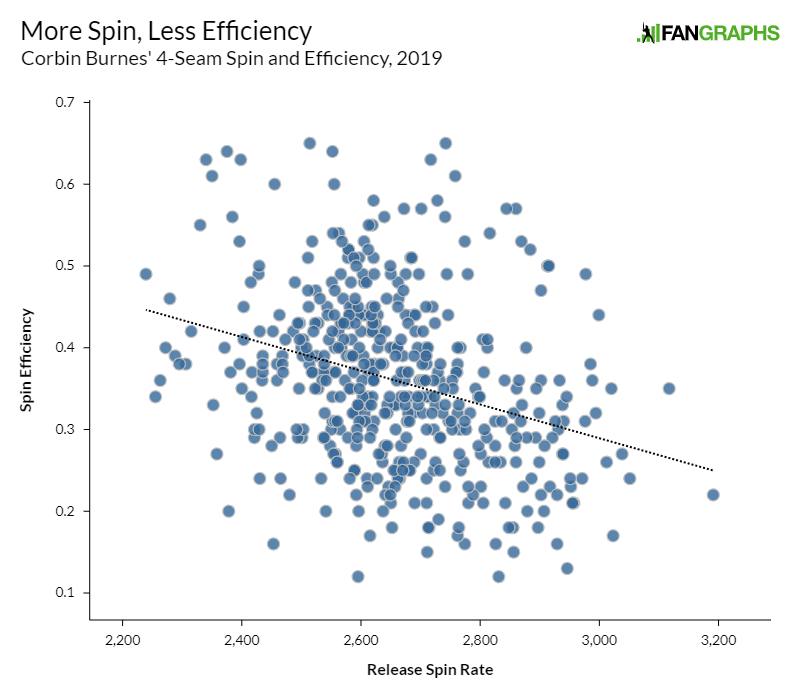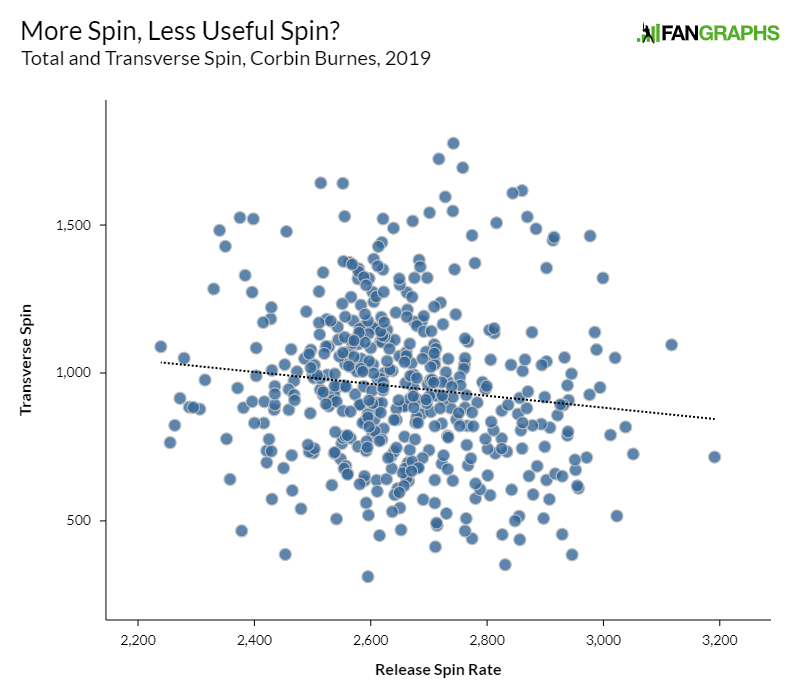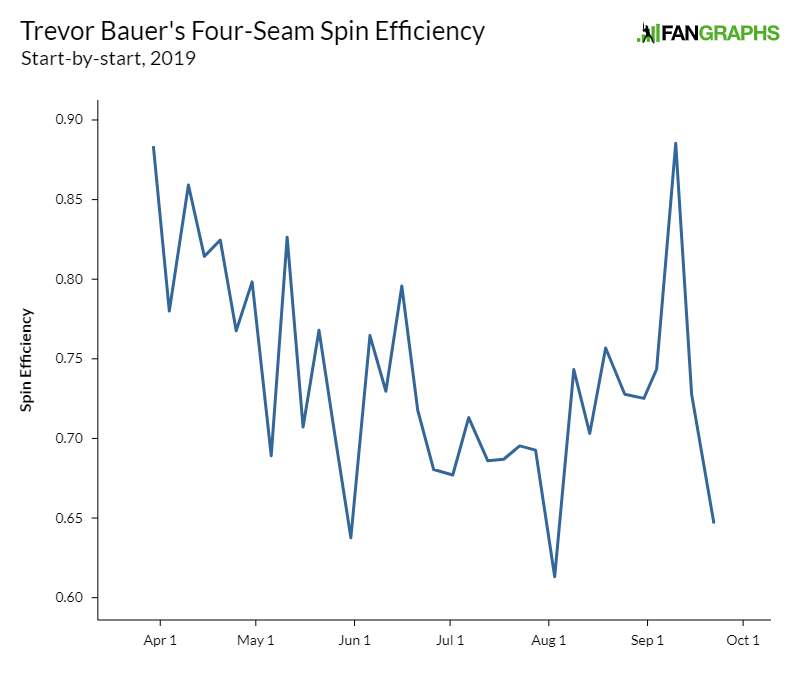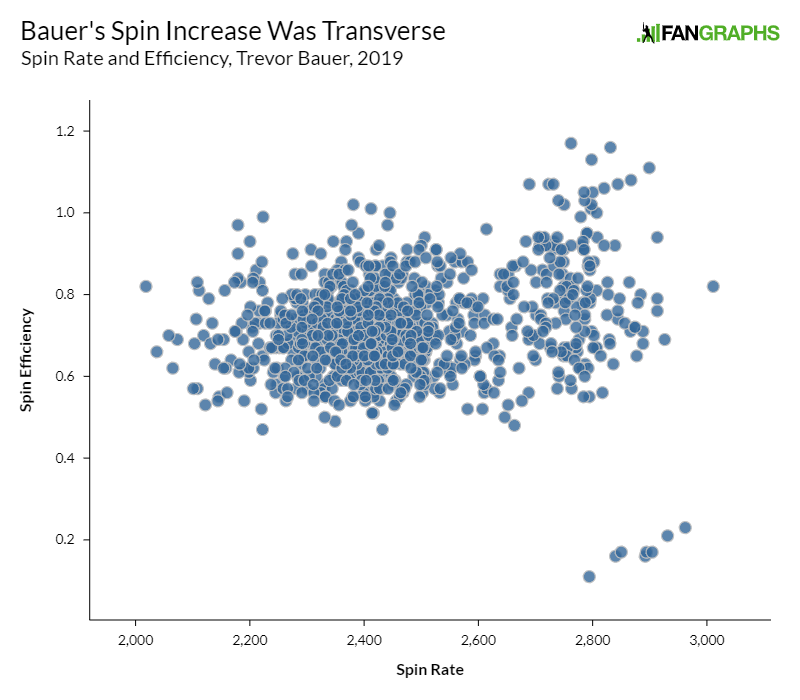Trevor Bauer Might Have Conducted Another Experiment
In April of 2018, Trevor Bauer conducted an experiment. While he never admitted it, he mysteriously threw the ball with significantly more spin for an inning. Given Bauer’s repeated insistence that adding pine tar or some other equivalent foreign substance could increase his spin rate by 200-300 rpm, and the fact that his spin rate was almost exactly 300 rpm higher in the first inning as compared to the rest, he might as well have winked.
So, uh, let’s talk about last September. The following graph is Bauer’s average four-seam fastball spin rate by game:

Now, I’m not a baseball scientist. But short of Alan Nathan and Meredith Wills and David Kagan, those are in short supply. So I thought I’d conduct a non-rigorous but still curious investigation of these September starts to see if I could get to the bottom of what happened.
Let’s get something out of the way first: my base case, before I started investigating, is that Bauer got back into the sticky stuff. The jump is just so clean, so consistent within each game, that it doesn’t look at all accidental. In a single earlier game, on August 19, Bauer seemingly discovered some spin, posting his then-highest single game average spin rate, just over 2500 rpm. For the rest of 2019, however, he lived between 2250 and 2500 rpm. Then, like magic, every single pitch Bauer threw in September had a spin rate higher than 2500 rpm.
What could cause this, if it isn’t some type of sticky substance? It’s a long shot, but maybe Bauer started cutting the pitch. What does that mean? If you already know, you can skip this section, but I’ll go over it quickly. Picture a tire rolling down the road. Now, picture that same motion by a ball in air, with no road in the way. That’s transverse spin. Picture the baseball with that tire-style spin, with the car in reverse, and you have a 100% spin efficiency fastball.
The ball tumbles “backwards” towards the plate, and that backspin creates ride, which makes the pitch fall less than gravity would imply. That type of spin can be oriented in any direction — you can tilt the direction the spin moves to, say, make the ball break right and up at a 45 degree angle. When you hear pitch angles referred to by a time on a clock face, this is what they’re talking about.
Next, consider a football thrown with a perfect spiral. That’s gyroscopic spin — the ball is spinning, but not in a way that alters its trajectory. It’s also called bullet spin, and it’s no coincidence that bullets and perfectly thrown footballs fly true, with no unexpected break. You don’t often see a baseball thrown like a football, but sliders and cutters are generally thrown with some mixture of transverse and gyroscopic spin. Some of their spin imparts a curve onto the ball, but some is gyroscopic and doesn’t create break.
Want an example of this? Look at Corbin Burnes. He spiked his fastball spin rate to great heights last year, and I erroneously saw a breakout. What happened here was that he added gyroscopic spin by giving the fastball some natural cut. Take a look at how his spin efficiency (the percentage of a pitch’s spin that is transverse, or “useful”) declined as his spin rate increased:

In fact, there was a slight relationship between Burnes’ overall spin rate and his transverse spin rate:

In other words, when he added spin, he was more or less exclusively adding gyroscopic spin. Every extra rpm of total spin decreased his transverse spin by 0.2 rpm. There’s not a straightforward relationship between spin rate and movement. Throwing a pitch harder will generally impart more spin on it, but it will also give the pitch less time to break. But one relationship isn’t confusing: for a pitch thrown at the same velocity, more transverse spin means more break. More spin and more transverse spin aren’t the same thing, though, as Burnes demonstrates.
There’s just one problem with this theory: Bauer wasn’t cutting the ball. With the exception of his last start of the season, his spin efficiency hardly changed — and in one start, it spiked higher:

In fact, if you look at all the pitches he threw last season, the relationship looks wholly different to Burnes’ (note that as our graphing tool accepts only 1000 events, I’ve removed the first 429 fastballs of the year):

Don’t mind those dots above 100% spin efficiency; I calculated transverse spin using this excellent guide from Dr. Alan Nathan, and as he notes, measurement error in either the initial 9-parameter fit or the listed spin rate can create efficiency numbers above 100%. Measurement errors are inevitable, but over time the process works. There was a cluster of over 100% efficient pitches on September 10, for any enterprising investigators out there, but I’m just going to accept the measurements in service of finishing this article.
In any case, Bauer didn’t display the same relationship as Burnes. A very useful study by Driveline Baseball showed that adding cut can increase total spin output at the expense of efficiency, but we don’t see the telltale decline in spin efficiency, so that’s not what’s happening here.
If it’s not a cutter, what else could it be? As I mentioned above, spin and speed have a linear relationship. That’s intuitive — to throw something harder, you need to increase the force you apply to it. That force is also creating spin, though, so the two end up linked. Driveline came up with a concept called Bauer units that is simply spin divided by velocity that lets us compare spin rates at unlike velocities. Did Bauer just start throwing harder?
Nope! He actually averaged one mile an hour less in September than he did the rest of the year. Perhaps he was tiring, or perhaps he was using some hitherto unseen tactic that added spin at the expense of velocity, but you certainly can’t explain his increased spin rate with Bauer units. His rpms per mph (an ugly way of writing out Bauer units) spiked from roughly 25 to 29.5 in September.
I find it unlikely that we’ll ever get to the bottom of what caused this sharp spin increase. Bauer has always been quick to explain himself, quick to walk through the nitty-gritty details of pitching, but this feels different. If he was unwilling to conclusively admit that he’d goofed around with pine tar for an inning in 2018, I hardly think he’d admit to using it for a month in 2019.
But that 2018 start can still be instructive. The end goal of spin isn’t spin itself; it’s movement. That’s why we care about spin efficiency and transverse spin. In that fateful inning in 2018, Bauer got a ton of extra movement on his fastball. In the first inning, the ball broke an average of 21.7 inches from the time it left his hand to the time it crossed the plate. Note that this is from the point of release — Brooks Baseball, where you can see similar numbers, normalizes break at 40 feet so that all pitchers can be compared regardless of release point, but I’m skipping that step here since we’re only looking at one pitcher.
For the rest of that game, with the tar rinsed off, Bauer averaged 19.7 inches of break. He had created two inches of movement out of whole cloth. This relationship doesn’t exist in a vacuum — again, velo matters — but his velocity was nearly unchanged between the first inning and the rest of the game. It was simply the pine tar.
Did we see the same increase in movement in the September starts? More or less:
| Time Frame | Velocity (mph) | Spin Rate (rpm) | Total Break (in) | Spin Efficiency |
|---|---|---|---|---|
| Pre-September | 94.6 | 2358 | 19.4 | 0.74 |
| September | 93.5 | 2755 | 20.8 | 0.75 |
In the end, maybe the Bauer story isn’t so interesting. He did something in 2018 that made the ball spin and move more. In 2019, the same pattern repeated itself over more games. It’s not clear what changed, and it didn’t even have much effect on his starts — his swinging strike and whiff per swing rates barely budged in the month, though that anomalous September 10 start merits further investigation.
That doesn’t mean it had no effect, however. Maybe Bauer’s numbers would have been worse without the spin boost. Maybe he really did get that extra spin by sacrificing velocity through use of some technique that isn’t yet publicly known, and the decline in velocity offset the increase in movement. He has been known to experiment, after all. But for the most part, it’ll simply remain unexplained. We won’t know whether it’s a new normal or just a one-month experiment until we get some 2020 data.
Was this article really about Trevor Bauer? Was it just an excuse to show off some fancy math and talk about my longtime pitcher crush Corbin Burnes? I leave that determination to the reader. But either way, Bauer, as he is wont to do, did something interesting last September. All we can do now is puzzle at the results and wonder what the causes were.
Ben is a writer at FanGraphs. He can be found on Bluesky @benclemens.

Ben and Corbin, sittin in a tree…
I thought this was fun (especially given Bauer’s invitations to be interrogated about pitching, other things) and perfect for that “waiting for the Red Sox report/inevitable Manfrailure” pre-opening day lull